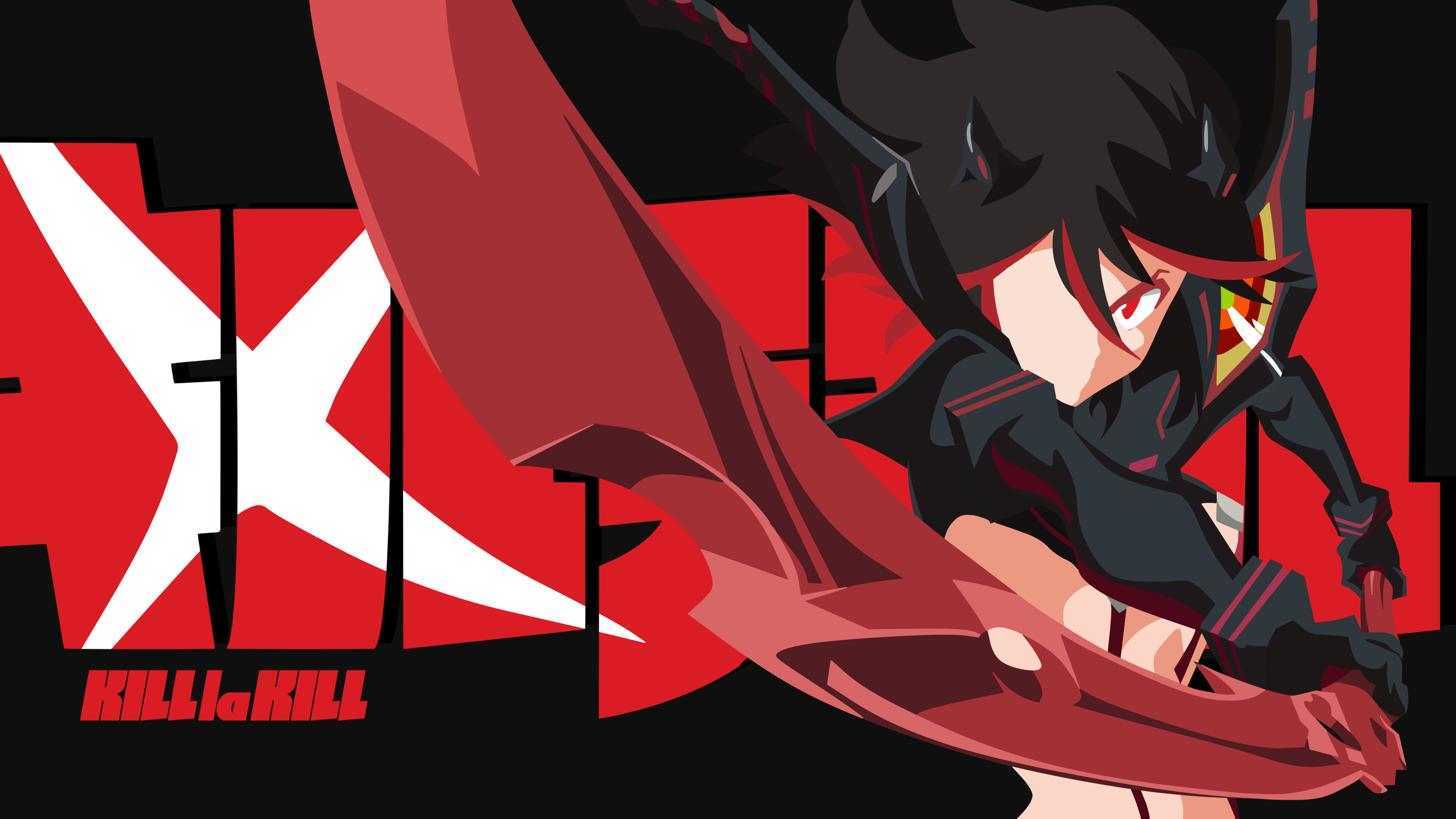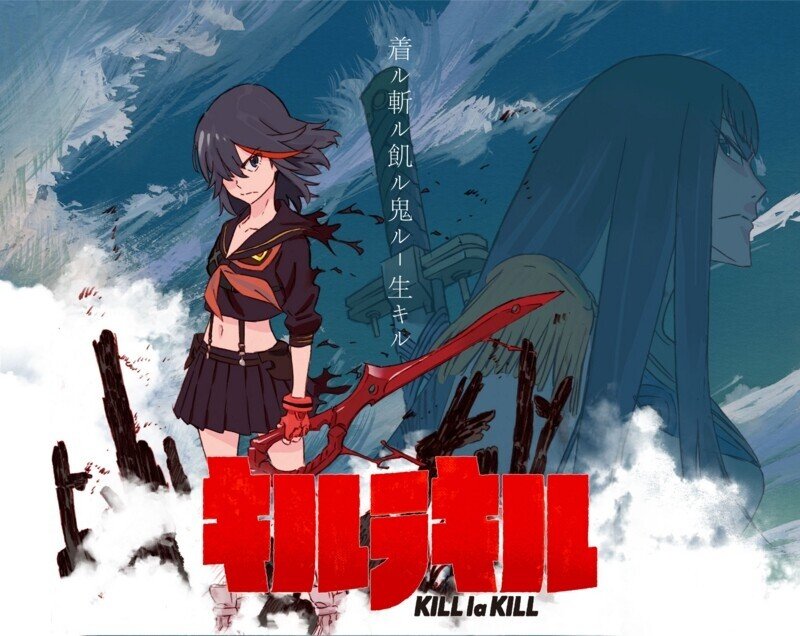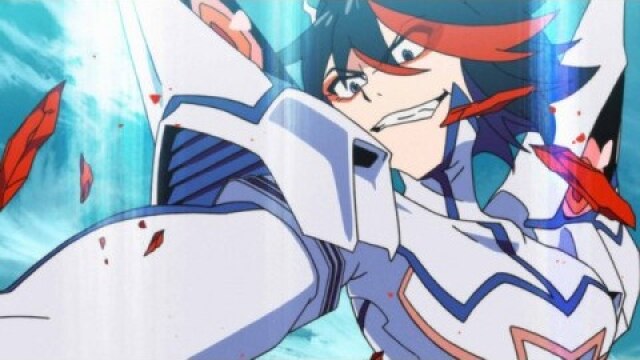Contents
Introduction to 'Kill la Kill'

Welcome to the exhilarating world of 'Kill la Kill,' an anime that defies the norms with its bold style and intense narrative. Have you ever wondered what makes this series stand out in the vast anime landscape? Well, you're in for a treat! Dive into this unique anime, produced by the renowned Studio Trigger, and discover how it blends outrageous action with deep themes of power, identity, and ambition.
So, what's 'Kill la Kill' all about? It follows the story of Ryuko Matoi, a feisty schoolgirl on a quest to find her father's killer. Her only lead is the other half of his invention, the Scissor Blade. Ryuko's search leads her to Honnouji Academy, an imposing fortress-like school ruled by the iron-fisted Satsuki Kiryuin and her Elite Four. Here, clothes literally make the man or woman powerful, thanks to 'Goku Uniforms' endowed with life fibers that give its wearers superhuman abilities.
Ryuko's arrival at Honnouji Academy shakes things up when she dons her own sentient sailor uniform, Senketsu, challenging the status quo in explosive battles that will have you on the edge of your seat. As Ryuko fights to uncover the truth behind her father’s death, she encounters fierce battles, uncovers secrets, and forms unexpected alliances.
'Kill la Kill' isn’t just another action anime; it's a spectacle filled with heart and a deep narrative. It explores complex themes such as the nature of power, the meaning of friendship, and the struggle against oppression—all wrapped up in what could be seen as a parody of magical girl and high school battle anime. The series is a whirlwind of over-the-top action sequences, vibrant characters, and a storyline that captures the imagination.
Why has 'Kill la Kill' captured the hearts of viewers around the world? Maybe it's the way the animation bursts with a raw energy that matches the intensity of the plot. Or perhaps it's how the series turns anime tropes on their heads, delivering a story that's both familiar and wildly original. Whatever the reason, one thing is certain: 'Kill la Kill' leaves a lasting impact with its unique blend of humor, drama, and action.
Stay tuned as we delve deeper into the characters, the revolutionary artistic style, and the unforgettable fights that make 'Kill la Kill' a true gem in anime history. Join Ryuko on her journey to slice through the shadows of deception and seize control of her destiny, one battle at a time. It's more than just a fight—it's a quest to redefine what power really means in a world where clothing could be your greatest ally or your worst enemy. Ready to dive in? Let's unravel the threads of 'Kill la Kill' together!
Main Characters and Their Dynamics

In the vibrant and action-packed universe of 'Kill la Kill,' the characters are far from ordinary. They bring the story to life with their complex relationships and evolving dynamics, making this series a standout in the anime genre. Let's dive into the core characters who drive the narrative forward through intense battles and emotional growth.
Ryuko Matoi, the fiery protagonist, arrives at Honnouji Academy with a singular goal: to find her father's murderer. Armed with her half of the Scissor Blade, her journey quickly turns into one of self-discovery and rebellion. Ryuko is not just fighting opponents; she's challenging societal norms and the oppressive school hierarchy led by the authoritarian Satsuki Kiryuin.
Satsuki Kiryuin, the president of the student council and the de facto ruler of Honnouji Academy, stands as both Ryuko's nemesis and later, her unlikely ally. Satsuki is the epitome of power and grace, wielding her Bakuzan sword and wearing the imposing Junketsu uniform. Her leadership is stern but also shows layers of complexity as her true motives unfold, revealing her own battle against the corrupt forces controlling their world.
The relationship between Ryuko and Satsuki is one of the series' highlights, evolving from fierce rivalry to a mutual respect as they uncover deeper family secrets and the truth about the Life Fibers. This dynamic shift is key to the series' thematic exploration of power, legacy, and kinship.
Supporting them are the Elite Four, Satsuki's loyal protectors, each with their own unique Goku Uniforms that grant them superhuman abilities. Among them, Ira Gamagoori, Uzu Sanageyama, Nonon Jakuzure, and Houka Inumuta not only provide formidable challenges for Ryuko but also have their own personal growth arcs that contribute to the series' narrative depth. Their loyalty and interaction with Satsuki help in highlighting themes of honor and the morality of leadership.
Lastly, Mako Mankanshoku, Ryuko’s best friend, adds a layer of heartfelt humor and simplicity to the otherwise intense narrative. Her unwavering support and her family provide Ryuko with the emotional anchor she needs to stay grounded amidst chaos.
Together, these characters create a rich tapestry of interactions that drive the series' central conflicts and philosophical questions. Through their relationships, 'Kill la Kill' examines themes of authority, rebellion, and identity, all woven into the fabric of its dramatic and comedic scenes. As viewers, we not only enjoy the intense action sequences that these characters navigate, but we also resonate with their struggles and triumphs, making 'Kill la Kill' a deeply engaging series that challenges and entertains.
Themes and Symbolism

'Kill la Kill' is not just an anime about high school battles; it's a thought-provoking series that delves into deep themes of power, control, and freedom, all wrapped in highly symbolic visuals that challenge traditional norms. This article explores the intricate themes and symbols that make 'Kill la Kill' a standout anime, resonating with a diverse audience.
Authority and Rebellion: At its core, 'Kill la Kill' centers around the theme of rebellion against oppressive authority. Honnouji Academy, led by the iron-fisted Satsuki Kiryuin, represents a microcosm of a totalitarian regime where students are ranked and rewarded based on their compliance and strength. Ryuko Matoi’s arrival and challenge to this order symbolizes the struggle of the individual against a suppressive system, questioning the legitimacy of power and how it's enforced.
The Power of Clothing: One of the most striking symbols in 'Kill la Kill' is the use of clothing as a metaphor for power and social status. The Goku Uniforms, made from Life Fibers, grant their wearers superhuman abilities, illustrating how clothing can literally and figuratively "make the man." Ryuko’s own transformation and battles using her sentient sailor uniform, Senketsu, highlight the conflict between using power for liberation versus oppression.
Identity and Self-Acceptance: Through the battles and interactions between characters, 'Kill la Kill' also addresses themes of identity and self-acceptance. Ryuko’s journey is not only about avenging her father but also about understanding her own identity independent of her uniform’s influence. This theme resonates with viewers, especially younger audiences, as it parallels the search for personal identity during the tumultuous teenage years.
Feminism and Empowerment: The anime subtly tackles issues of feminism and empowerment. Unlike typical portrayals of female characters in media, Ryuko and Satsuki are portrayed as strong, independent figures who defy gender expectations. Their power and agency drive the narrative forward, presenting a dynamic view of female empowerment.
Family and Connection: Beneath its vibrant battles, 'Kill la Kill' explores the dynamics of family and the connections that bind characters. The complex relationship between Ryuko and Satsuki, which evolves throughout the series, questions the nature of familial bonds and loyalty, ultimately advocating for a chosen family built on trust and mutual respect.
Through these themes, 'Kill la Kill' does more than entertain; it invites viewers to reflect on deeper societal issues, making it a culturally impactful series. The unique blend of action, comedy, and meaningful symbolism ensures that 'Kill la Kill' remains a memorable experience that challenges viewers to think critically about the world around them.
Artistic Style and Animation Techniques

'Kill la Kill' is renowned not only for its intense storytelling but also for its unique artistic style and innovative animation techniques that set it apart in the anime industry. This analysis delves into the visual and technical elements that define the series, providing insights into how these contribute to the overall impact of the show.
Bold Lines and Vibrant Colors: One of the first things you’ll notice about 'Kill la Kill' is its distinctive use of bold, thick lines and bright, contrasting colors. This approach not only gives the series a very dynamic visual style but also enhances the emotional intensity of the scenes. The vivid reds and deep blacks, for example, underscore the aggression and conflict that are central to the storyline.
Fluid Animation and Exaggerated Expressions: The animation in 'Kill la Kill' is characterized by its fluidity and exaggerated character expressions. These elements are crucial in conveying the fast-paced action and the over-the-top drama that the series is famous for. The animators at Studio Trigger have mastered the art of using fluid motion to depict rapid combat scenes that maintain clarity and coherence, making each battle a spectacular display of animation prowess.
Creative Camera Angles and Transitions: The use of unconventional camera angles and innovative transitions in 'Kill la Kill' significantly enhances the narrative delivery. These techniques are employed to create a more dynamic and immersive viewing experience, often placing the audience right in the middle of the action. Such angles and transitions also help in depicting the scale and intensity of the battles, adding a cinematic quality to the series.
Integration of Textures and Patterns: 'Kill la Kill' incorporates unique textures and patterns within its animation, which play a symbolic role in the narrative. The patterns used in the clothing of the characters, particularly the Goku Uniforms, are not just decorative but are indicative of their power levels and roles within the school hierarchy. This thoughtful integration of design elements into the storyline enriches the visual storytelling.
Symbolic Use of Lighting and Shadows: The strategic use of lighting and shadows in 'Kill la Kill' is pivotal in setting the tone and mood of various scenes. Dramatic lighting highlights the intensity and drama, while shadows are often used to convey mystery and suspense. This manipulation of light and shadow effectively underscores the emotional and psychological states of the characters.
Through these artistic and animation techniques, 'Kill la Kill' offers a visual feast that is both stunning and meaningful. The series pushes the boundaries of traditional anime aesthetics, creating a distinctive style that is as rebellious and impactful as its storyline. By integrating advanced animation methods with bold artistic choices, 'Kill la Kill' not only tells a compelling story but also leaves a lasting impression on its audience, redefining what is possible in the realm of animated storytelling.
Cultural Impact and Legacy

'Kill la Kill' is not just an anime; it's a cultural phenomenon that has left an indelible mark on the landscape of modern animation. This analysis explores how the series has influenced pop culture, anime fandom, and the broader media discourse since its debut.
Breaking Conventional Boundaries: 'Kill la Kill' is celebrated for its fearless storytelling and unconventional themes. It challenges societal norms through its narrative and visual style, which blends hyper-action with a deep critique of social structures concerning fashion, power, and identity. This bold approach has sparked discussions on various platforms, from anime conventions to academic forums, highlighting its impact beyond mere entertainment.
Fan Engagement and Community Building: The series has cultivated a dedicated fanbase, evidenced by its active presence in online communities, fan art, cosplays, and fan fiction. These communities serve as a testament to the show's ability to resonate with viewers on a deeper level, fostering a space for creativity and expression that extends well beyond its broadcast run.
Influence on Anime Industry: 'Kill la Kill's innovative animation techniques and narrative flair have raised the bar for anime production. Its success has encouraged other studios to experiment with unique artistic styles and storytelling methods. The show's influence is evident in numerous subsequent anime that dare to deviate from the norm, pushing the boundaries of what anime can achieve both aesthetically and thematically.
Legacy in Media Representation: The show's portrayal of strong, complex female leads has contributed significantly to the conversation about gender representation in media. 'Kill la Kill' challenges traditional gender roles and has been pivotal in promoting discussions about feminism in anime, illustrating how media can influence perceptions and inspire dialogue on important social issues.
Merchandising and Beyond: The commercial success of 'Kill la Kill' merchandise, which includes everything from apparel to action figures, underscores its cultural significance and the strong connection fans feel with the series. The merchandise continues to sell years after the series concluded, a clear indicator of its lasting appeal and impact.
Through its daring narrative, distinctive style, and profound cultural influence, 'Kill la Kill' continues to be a significant point of reference in the anime industry. Its legacy is defined not only by its contribution to entertainment but also by its challenge to cultural norms and its capacity to inspire a new generation of creators and critics. By continuously pushing the envelope, 'Kill la Kill' remains a critical piece of anime history that resonates with audiences worldwide, ensuring its place in the cultural zeitgeist for years to come.



